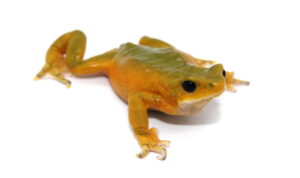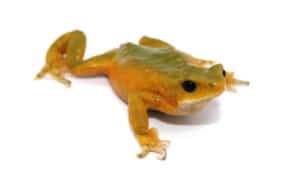Scientists in Ecuador rediscover 32 frog species once believed extinct
 26 Desember 2022
26 Desember 2022
Photo: Morley Read/Michigan State University
Amphibians in tropical rainforests have been up against increasingly grave challenges, but now and then comes good news that gives us cause for optimism.
In one such development ecologists at Michigan State University in the United States and their colleagues in Ecuador report that 32 harlequin frog species continue to survive in the wild despite having previously been considered possibly extinct.
“I can’t tell you how special it is to hold something we never thought we’d see again,” says Kyle Jaynes, a doctoral student at the university’s Department of Integrative Biology and the Ecology, Evolution and Behavior Program who was key to the research.
His team has found that these critically endangered frogs have a better chance of making it in the wild than previously assumed, but conservation efforts to preserve their habitats’ rich biodiversity will need to be stepped up in order to ensure that they do indeed survive.
“We want people to walk away from this with a glimmer of hope that we can still address the problems of the biodiversity crisis,” says Jaynes, who was an author of a study on the rediscovery. “But rediscovery does not equal recovery,” the scientist cautions. “This story isn’t over for these frogs, and we’re not where we want to be in terms of conservation and protection. We still have a lot to learn and a lot to do.”

Harlequin frogs belong to a genus of small amphibians that come in a dazzling array of color combinations. They have fallen on hard times in recent decades with more than 80% of its species having been driven to extinction or near it.
In addition to habitat loss and other stresses, they have also been decimated by a fungus called Batrachochytrium dendrobatidis at growing rates in a mass extinction that alarmed experts
However, sporadic sightings of frogs that were believed to have gone extinct kept raising hopes among biologists that the extinction rate among the frogs might be overstated. In 2019 Jaynes and his colleagues in Ecuador set out to look for scientific details on rediscovered frogs at five different sites in the rainforests of the South American nation.
They collected saliva samples from specimens for genetic studies and also examined the frogs’ skin for the presence of potentially harmful microbes, including Batrachochytrium dendrobatidis. Thanks to their efforts more than a third of frogs deemed possibly extinct have now been rediscovered.
“In total, 87 species have been missing. To date, 32 of those once-missing species — that’s 37% — have been rediscovered over the last two decades. This is a shocking number,” Jaynes explains.
“We didn’t think these frogs existed a decade ago. Now we have DNA samples. That information is invaluable,” the scientist adds.
These DNA tests have shown that the previously missing frogs have less genetic diversity than those that disappeared more recently, indicating smaller populations.
“Low genetic diversity is an indicator that a species could be more susceptible to future stressors from, say, a new strain of Batrachochytrium dendrobatidis or climate change or habitat loss,” Michigan State University explains in an article on the findings.
The scientists are now seeking to answer some unanswered questions to benefit conservation measures. “This study opens up a lot of other questions,” says Sarah Fitzpatrick, an assistant professor at the College of Natural Science who was another key member of the research team.
“For example, why are these frogs persisting? What we found points to the fact that there probably isn’t a single explanation. And now that we’ve described these frogs, how do we ensure their recovery?”
The post Scientists in Ecuador rediscover 32 frog species once believed extinct appeared first on Sustainability Times.
